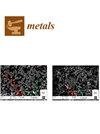Morphological Characteristics of W/Cu Composite Nanoparticles with Complex Phase Structure Synthesized via Reactive Radio Frequency (RF) Thermal Plasma
IF 2.5
3区 材料科学
Q3 MATERIALS SCIENCE, MULTIDISCIPLINARY
引用次数: 0
Abstract
The W/Cu binary system is characterized by its mutual insolubility and excellent wettability, making W/Cu composite materials ideal for managing thermal and electrical properties in electronic components. To optimize material properties, control over the microstructure is crucial, and nanocomposites with uniform dispersion offer significant advantages. In this study, W/Cu composite nanoparticles were synthesized by feeding a blended feedstock of tungsten trioxide (WO3) micro-powder and cupric oxide (CuO) micro-powder into a reactive radio frequency (RF) argon–hydrogen thermal plasma system. Cu-coated W nanocomposite particles were obtained through the vaporization, reduction, and condensation processes. The resulting nanocomposite particles were composed of body-centered cubic (BCC) α-W, A15 β-W, and face-centered cubic (FCC) Cu phases, with a chemical composition closely matching theoretical calculations. The phase evolution and morphological changes of the synthesized particles were analyzed as a function of heat treatment temperatures up to 1000 °C in a reducing atmosphere. Up to 600 °C, the phase composition and morphology remained stable. At 800 °C, localized diffusion and coalescence of Cu led to the formation of particulate Cu, and a significant phase transformation from metastable β-W to α-W was observed. Additionally, extensive Cu segregation due to long-range diffusion resulted in distinct Cu-rich and Cu-depleted regions. In these regions, notable sintering of W particles and the complete disappearance of β-W occurred. The results showed that the temperature-dependent redistribution of Cu plays a crucial role in the phase transformation of W and the morphology of W/Cu composite particles.通过反应射频(RF)热等离子体合成的具有复杂相结构的 W/Cu 复合纳米粒子的形态特征
W/Cu 二元体系的特点是互不相溶和极佳的润湿性,这使得 W/Cu 复合材料成为管理电子元件热性能和电性能的理想材料。要优化材料性能,控制微观结构至关重要,而均匀分散的纳米复合材料具有显著优势。本研究将三氧化钨(WO3)微粉和氧化铜(CuO)微粉的混合原料送入反应射频(RF)氩氢热等离子系统,合成了 W/Cu 复合纳米粒子。通过气化、还原和冷凝过程,获得了铜包覆的 W 纳米复合粒子。得到的纳米复合粒子由体心立方(BCC)α-W、A15 β-W和面心立方(FCC)铜相组成,其化学成分与理论计算结果非常接近。在还原气氛中,分析了合成颗粒的相演化和形态变化与高达 1000 ℃ 的热处理温度的函数关系。在 600 °C 以下,相组成和形态保持稳定。800 °C时,铜的局部扩散和凝聚导致了颗粒状铜的形成,并观察到了从β-W到α-W的显著相变。此外,由于长程扩散造成的广泛铜偏析,形成了明显的富铜区和贫铜区。在这些区域,W 颗粒明显烧结,β-W 完全消失。结果表明,随温度变化的铜再分布在 W 的相变和 W/Cu 复合粒子的形态中起着至关重要的作用。
本文章由计算机程序翻译,如有差异,请以英文原文为准。
求助全文
约1分钟内获得全文
求助全文
来源期刊

Metals
MATERIALS SCIENCE, MULTIDISCIPLINARY-METALLURGY & METALLURGICAL ENGINEERING
CiteScore
4.90
自引率
13.80%
发文量
1832
审稿时长
1.5 months
期刊介绍:
Metals (ISSN 2075-4701) is an open access journal of related scientific research and technology development. It publishes reviews, regular research papers (articles) and short communications. Our aim is to encourage scientists to publish their experimental and theoretical results in as much detail as possible. Therefore, there is no restriction on the length of the papers. The full experimental details must be provided so that the results can be reproduced. Metals provides a forum for publishing papers which advance the in-depth understanding of the relationship between the structure, the properties or the functions of all kinds of metals.
 求助内容:
求助内容: 应助结果提醒方式:
应助结果提醒方式:


